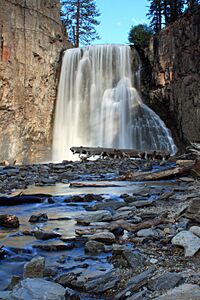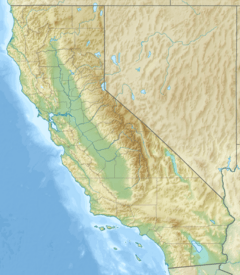Rainbow Falls (California) facts for kids
Quick facts for kids Rainbow Falls |
|
|---|---|
 |
|
| Lua error in Module:Infobox_mapframe at line 185: attempt to index field 'wikibase' (a nil value). | |
| Location | Madera County, California, United States |
| Coordinates | 37°36′06″N 119°05′00″W / 37.60167°N 119.08333°W |
| Elevation | 7,415 feet (2,260 m) |
| Total height | 101 feet (31 m) |
| Number of drops | 1 |
| Watercourse | San Joaquin River |
Rainbow Falls is a beautiful and tall waterfall in the Sierra Nevada mountains of California, United States. It is the highest waterfall on the Middle Fork of the San Joaquin River. The water drops 101 feet (31 m) into a churning pool below.
This amazing waterfall gets its name from the bright rainbows you can often see in its mist. These rainbows appear on sunny summer days when the light hits the water spray just right. Rainbow Falls is found inside the Devils Postpile National Monument.
How Rainbow Falls Was Formed
Rainbow Falls was created by powerful natural forces over many thousands of years. About 75,000 years ago, hot, melted rock called lava burst out from the ground. This happened near where the waterfall is today.
Lava Flow and Cooling
The lava eruption happened in two main stages. First, a wave of lava flowed about 1 kilometre (0.62 mi) west. It settled in the valley of the Middle Fork of the San Joaquin River. Then, a second wave of lava flowed on top of the first. This top layer acted like a blanket. It kept the first layer warm, allowing it to cool down very slowly.
As the lava cooled slowly, it cracked in a special way. It formed tall, straight cracks that went up and down. The top layer of lava cooled faster and cracked sideways. Geologists, who study rocks, call these rocks platy rhyodacite. You can see these unique rocks in the cliffs around Rainbow Falls.
How Water Shapes the Falls
Water is very powerful and can change the land over time. As the river water rushes over the cliff, it wears away the rocks. The rocks with the straight, up-and-down cracks are easier for the water to erode.
Over time, a small cave starts to form at the bottom of the waterfall. When this happens, the rock above the cave loses its support. Eventually, it breaks off and falls down. This process is called undercutting. It causes the waterfall to slowly move backward, or upstream. So far, Rainbow Falls has moved back about 500 feet (150 m) because of this undercutting process.


